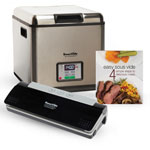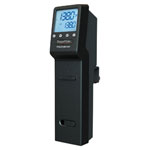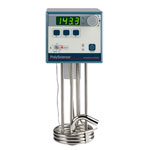What is sous vide anyway?
Sous vide (SOO veed) is French for “under vacuum”, or the simple technique of cooking food sealed in a bag in a hot water bath. And recently, it’s being used more and more. You can control how your food comes out much more accurately with sous vide. Steak cooked to a certain temp in a waterbath will not overcook, and will be consistently the same color, texture and temperature throughout (as compared with grilled meats dry on the outside and juicy on the inside).
When you roast/grill beef the traditional way and take it off the heat, the meat still cooks. You let it “rest” for a while before carving or serving. But I remember many a time on the line, plating a top sirloin, only to have it sit and bleed out while we waited for servers to actually serve their food. Then have it come back as being too well done! Damn, I hated that…
With sous vide, once meat reaches the temp of its waterbath, it’s not going to keep cooking beyond what you want.
American Chefs Thomas Keller and Grant Achatz are strong proponents of the technique, Keller so much so, that he came out with Under Pressure, a seminal book on the subject. I highly recommend this book, as it goes into every detail of the sous vide cooking method, including history, safety tips, best practices, methods and recipes.
There are many ways to cook sous vide. And people have been cooking en sous vide for hundreds of years. Heck, I’m sure your Mom even boiled some rice in a bag when you were a kid! I’ve been using a pot of water and a digital thermometer for years, with passable results. The trick with that old-fashioned way is to try and keep the temperature constant — nearly impossible. Other, more accurate methods involve water and electricity — a time-honored favorite of many cooks, chefs and serial killers…
Many of the recipes I’m cooking from Achatz’ Alinea Restaurant cookbook include sous vide cooking, so I recently broke down and got the SousVide Supreme water oven and vacuum sealer package, and am loving it. Sure beats that pot o’ water!
Products
Here are some commercial sous vide cooking solutions out there now. I have not listed the DIY rigs you can make with a rice cooker, but those are still viable options if you just don’t want to spend the money on any of these.
 SousVide Supreme™ water oven from Eades Appliance Technology
SousVide Supreme™ water oven from Eades Appliance Technology
Turn-key sous vide solution. The SousVide Supreme “water oven” easily fits on a countertop, comes in two sizes: the SousVide Supreme, the SousVide Supreme Demi, and is available in several colors/finishes. Prices range from US$299.00 to $459.00.
Pros:
Most affordable option.
All-in-one design.
Easy-to-use electronic panel.
Stainless interior components are easy to remove and clean.
Available in 8.7-liter and 10-liter capacities.
Cons:
You’re limited to its fixed size (But I fit a whole duck in the SousVide Supreme)
Temperatures only programmable to within 0.5°C (for example, you can only come close to 80.7°C, but really…)
 Sous Vide Professional™ Chef Series immersion circulator from PolyScience
Sous Vide Professional™ Chef Series immersion circulator from PolyScience
Compact and attractively designed, this thermal immersion circulator from CuisineTechnology.com sells for US$799.95. Second generation product is prettier than the original Sous Vide Thermal Circulator.
Download a Sous Vide Temperature Reference Guide.
Pros:
Clean design.
Easy-to-use electronic panel.
Heats and circulates up to 8 gallons of water.
Temperatures accurate to within 0.09°F (0.05°C).
Comes with a carrying case.
Cons:
Not self-contained — you need a vessel (and lid) for your water bath.
More expensive.
 Sous Vide Thermal Circulator™ from PolyScience
Sous Vide Thermal Circulator™ from PolyScience
The original, laboratory-equipment design by PolyScience was adopted by chefs for sous vide cooking. An immersion circulator circulates the water. A thermal immersion circulator circulates and heats the liquid. Still selling strong, this thermal immersion circulator from CuisineTechnology.com sells for US$1,022.00.
Pros:
Easy-to-use electronic panel.
Heats and circulates water in a bath.
Temperatures accurate to within 0.09°F (0.05°C).
Available with a protective metal shield for circulator coils, and an optional hard carrying case.
Cons:
Not self-contained — you need a vessel (and lid) for your water bath.
Circulator coils are exposed and may get dinged.
Much more expensive.

4 Responses to Cooking Sous Vide